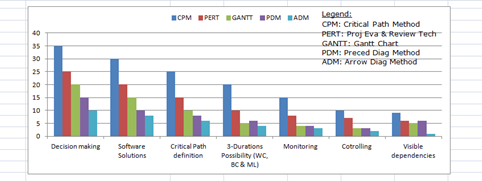1. Problem recognition, definition and evaluation
Project managers are usually faced with decision environments in which there are a number of considerations and conflicting objectives such as minimizing the total project costs, meeting certain contract and delivery dates, conflicting expenses on a fixed budget, and ensuring that certain activities achieve certain quality levels. Hence, the use of Best Practice Network Technique is required for the entire Project Management phases (Planning, Monitoring, Controlling and Reporting).
2. Development of the feasible alternatives
Currently, there are several Network Techniques available in Project Management practice:
1. CPM – Critical path method is based on mathematical calculations and it is used for scheduling project activities. This method was first introduced in 1950s as a joint venture between Remington Rand Corporation and DuPont Corporation. CPM method as a computer-based technique enhances the use of appropriate software solution in project management.
2. PERT - Project Evaluation and Review Technique is primarily developed to calculate the time duration that will be taken to complete the project. The technique helps in calculating the minimum and maximum duration that is required to complete the project.
3. Gantt Chart - A Gantt chart is a type of bar chart, developed by Henry Gantt in the 1910s, that illustrates a project schedule. Gantt charts illustrate the start and finish dates of the terminal elements and summary elements of a project.
4. PDM - The precedence diagram method is a tool for scheduling activities in a project plan. It is a method of constructing a project schedule network diagram that uses boxes, referred to as nodes, to represent activities and connects them with arrows that show the dependencies.
5. ADM - Arrow diagramming method (ADM) is a network diagramming technique in which activities are represented by arrows. ADM is also known as the activity-on-arrow (AOA) method. Use of ADM as a common project management practice has declined with the adoption of computer-based scheduling techniques.
3. Development of the outcomes and cash flows for each alternative
4. Selection of the acceptable criteria
An important component of the project baseline is the completion of a network schedule. Best Practice schedule technique easily defines critical path, visible dependencies, effective decision making, enhances use of appropriate software solution and shows if the project is progressing according to plan.
5. Analysis and Comparison of the alternatives
The CPM method enables comparison of the current schedule with the baseline schedule to see if the project is proceeding according to plan. Variances from the baseline schedule can also be addressed with corrective actions and work around plans. The large amount of project data can be organized & presented in diagram for use in decisions making.
6. Selection of the preferred alternative
From the preference ranking above, the use of CPM is the acceptable Best Practice, in order to determine the critical path of a network, considering not only time but also cost, quality, and safety criteria.
7. Performance Monitoring and Post Evaluation of Results
Since project schedules change on a regular basis, CPM allows continuous monitoring of the schedule, allows the project manager to track the critical activities, and alerts the project manager to the possibility that non-critical activities may be delayed beyond their total float, thus creating a new critical path and delaying project completion. In addition, the method can easily incorporate the concepts of stochastic predictions, using the Program Evaluation and Review Technique (PERT) and event chain methodology.
8. References/Bibliography
- CPM vs. PERT CPM or "Critical Path Method": tool to analyze project and determine duration, based on identification of "critical path" through an activity network: http://home.snc.edu/eliotelfner/333/stones/page3.html
2. AACE International Recommended Practice Updated No. 11R-88
3. Dr. Paul D. Giammalvo, AACE Cost Engineering Journal March/April 2013 Edition:



Sorry Austin, you need to go back and REDO this one..... You don't have a complete grasp or understanding.......
ReplyDeleteCPM comes in two forms- ADM and PDM So those two are SUBSETS of CPM not separate but subsets of.
PERT is NOT a scheduling method at all. It is a RISK MANAGMENT method. Go to MSP 2003 or 2007. Click on VIEW, then MORE VIEWS and find PA Pert Entry. All PERT does is change the duration's from the 50th percentile or average to the P85 or P90 duration.
Bottom line- my best advice would be to review my handouts from Day 4 and spend more time researching the DIFFERENCE between ADM and PDM. ADM is no longer used and there is a good reason for it. Suggest you do another posting using Force Field Analysis to show us WHY PDM has replaced ADM.
Start here-
http://www.mosaicprojects.com.au/PDF_Papers/P110_Calculating_and_Using_Float.pdf
Look for papers by Pat Weaver or Murray Woolf especially.......
BR,
Dr. PDG, Jakarta